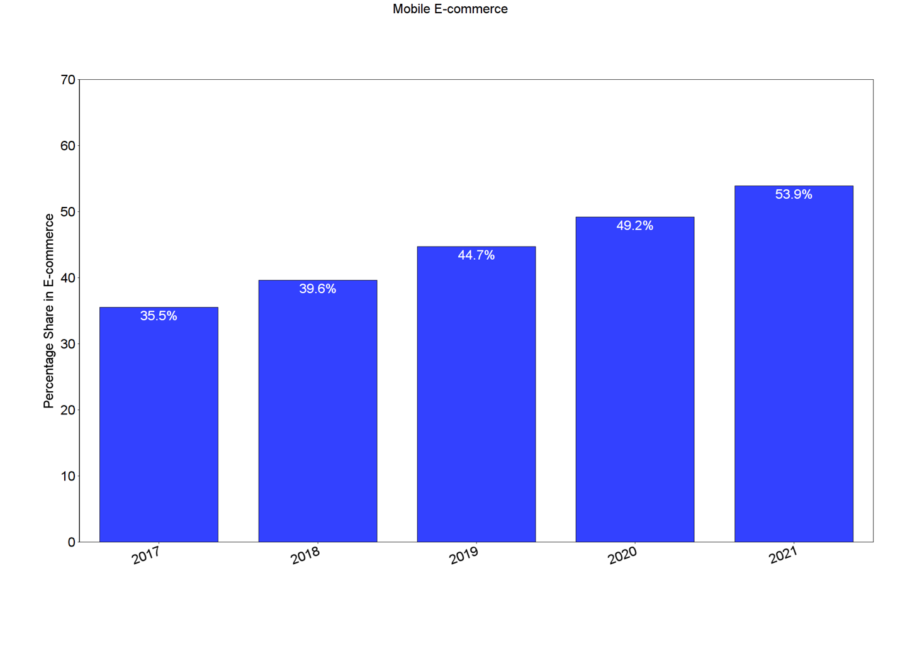Mobile phones have dominated nearly every aspect of modern lives. With smartphones accompanying us everywhere, it would not be wrong to say that they influence how we work, enjoy, and shop. In recent years, mobile commerce has picked up a phenomenal pace.
Experts predict that mobile commerce will dominate the eCommerce industry with 54% ($ 659 billion) in sales by the year 2021.
Share of mobile commerce in eCommerce Industry – 2017-2021

Source: Pixelunion
Mobile commerce is beneficial, both for sellers, as well as buyers. While for buyers, it means convenience, for seller mobile commerce promises quicker conversions and sales.
According to a study, 70% of mobile searches result in an action within an hour of the search. There are several other benefits of mobile commerce including:
- Improved customer experience
- Better targeting and engagement owing to push notifications
- Personalized content delivery according to shopping preferences
- Reduced cost of operations
With exciting benefits and phenomenal growth trajectory, mCommerce is here to stay and rule the entire industry. But what trends and patterns will rule the mobile commerce arena.
Let’s have a look at some of the interesting mobile commerce trends for the future.
Mobile Commerce Trends for the Coming Year
- Shopping via mobile apps will continue to rise
As mentioned above, the share of mobile commerce in the eCommerce industry will keep on growing with each passing day.
Already, the share of mobile commerce on big shopping events like Black Friday and Cyber Monday have broken all past records. Mobile commerce was responsible for 66% of sales during Black Friday/Cyber Monday. With increased usage of mobile apps, the mobile shopping share will keep on swelling. Not only B2C, B2B mobile ecommerce is also getting bigger and industry is expected to 1.1 trillion in 2020
- Fast Loading Mobile Apps & Websites
Customer experience is everything in the digital world. Users have a dwindling attention span and are quite impatient. The changing consumer behavior will give way to the growth of fast-loading mobile apps and websites.
40% of users abandon a page that takes more than 3 seconds to load.
According to several industry surveys, it has been established that users tend to prefer buying from mobile apps that are quick to load. The slower an app loads, increased are the chances of abandonment.
- Faster checkouts for higher conversions
Easy checkout options will definitely keep on impacting the conversion rates of eCommerce websites and mobile apps. Single-click checkout and payment via digital wallets improve the customer’s buying experience, which ultimately leads to more sales.
If a mobile website or app has these options, there will be greater chances that a user will end up buying.
- Smart site search & navigation for increased conversions
The easier it is for customers to find products, greater are the chances that they will end up buying something. Mobile websites and apps will continue to improve the customer experience by simplifying navigation, adding dynamic product pages and autocomplete features to search option.
If a user can find their desired product quickly on a mobile commerce platform, he/she will purchase thus improving conversions and bottom line.
- Buyers directly using social apps for making purchases
Social commerce is the process of directly selling something using social platforms such as Facebook, Instagram, Twitter, etc. With the coming of Instagram Shopping Posts in 2018, the whole social commerce opportunity suddenly seems more lucrative.
According to studies, 51% of millennials are more likely to buy products via social media.
The social commerce trend will pick up speed and impact the entire mobile commerce segment in the coming years, for sure.
- Technologies such as AI, AR and VR are the future of mCommerce
Innovative technologies such as Artificial Intelligence (AI), Augmented Reality (AR) and Virtual Reality (VR) will shape up new shopping experiences for mobile customers.
Using AI-powered smart shopping assistants, AR-based virtual shopping stores and host of other features, mobile commerce platforms can improve the shopping experience which will lead to more sales.
- Chats bots for instant response & better conversions
Live bots integrated into the mobile commerce stores have proven to be a game-changer when it comes to conversions and customer services.
By integrating live chatbots in their apps and mobile stores, companies would be seen shaping up decisions, helping buyers to make purchases easily, reducing the chances of abandonment.
- Omnichannel strategies will boost sales figures
Omnichannel strategies involve providing a seamless experience to the customers across different platforms, channels and networks. For mobile commerce, this means having a cross-platform application and a mobile website. Such strategies will refine and will lead to the creation of holistic shopping experience in the future.
Omnichannel strategies keep customers hooked across multiple platforms, increasing their chances of buying something from a mCommerce store. Turnkey mCommerce solutions enable startups to adopt omnichannel strategies quickly, which gives them a chance to improve their sales revenues.
- The Growth of Voice Search
Like every other industry, voice assistants like Alexa, Siri and Google Assistant will also impact mobile commerce in the coming years. Voice search is turning out to be an increasingly popular way for individuals to perform searches and even buy something on-the-go using their mobile phones.
Voice shopping is expected to grow to a level of $ 40 billion by 2022, from $ 2 billion at present.
The changing dynamics and growth of voice search call for a change in the conventional strategies. Modern eCommerce stores and mobile apps would have to embed voice-activated commands and target voice searches to improve their sales revenues in the future.
- Mobile Image Recognition Technology
Mobile image recognition technology will change the face of mobile commerce in the coming years. People will be able to search for products via image recognition technology on their mobiles. By just clicking a picture or pointing mobile camera on a product, mobile users will be taken to the shopping page of the respective product.
Final Words
It would be interesting to see these trends shaping our everyday shopping experiences, making them much more streamlined and better. For the store owners, too, this would mean an increase in sales, resulting in a mature ecosystem. Definitely, the mobile commerce domain is going to see a massive transition from its current model with the growth of new technologies and trends.
Digital & Social Articles on Business 2 Community
(48)






